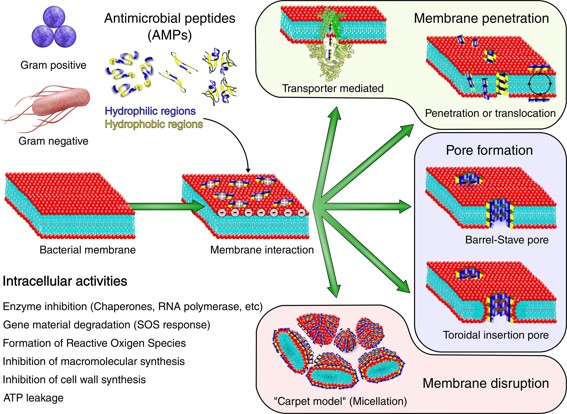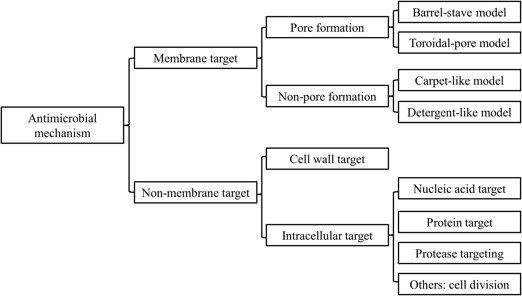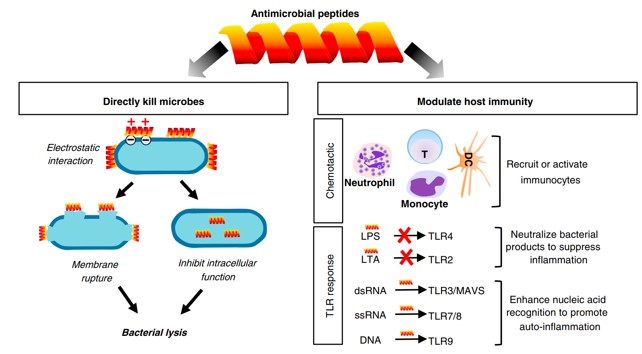Please kindly note that our products and services can only be used to support research purposes (Not for clinical use).
What is the Antimicrobial Peptide?
Antimicrobial peptides (AMPs) are diminutive, naturally occurring peptides that are integral to the immune defense system, demonstrating significant efficacy against many pathogens, including bacteria, viruses, fungus, and some cancer cells. Given the escalating issue of antibiotic resistance, AMPs have garnered interest as possible replacements or adjuncts to conventional antibiotics. This document provides an overview of the properties, methods of action, and uses of antimicrobial peptides.
 Fig.1 Antimicrobial peptides and their sources. (Ageitos J M., et al., 2017)
Fig.1 Antimicrobial peptides and their sources. (Ageitos J M., et al., 2017)Mechanisms of action of Antimicrobial Peptides (AMPs)
(1) Mechanism of membrane targeting
There is a negatively charged lipopolysaccharide component to the outer membrane of gram-negative bacteria, and there is also a plasma membrane. Outside the plasma membrane, gram-positive bacteria encase their cell walls with peptidoglycan and negatively charged teichoic acid, even though they lack an outer membrane. As a result, AMPs can use electrostatic attraction to interact with the membrane, laying a solid groundwork for breaking the membrane and entering the cytoplasm. It is worth noting that there could be additional draws in the initial contact than charge attraction. Other lipid characteristics, such membrane curvature, can affect the activity of certain AMPs. After an initial encounter, peptides tend to pool on the surface of the membrane, diffuse, and eventually self-assemble at high enough concentrations. To better understand this procedure, other models have been put forward.
A peptide monomer aggregates on the membrane according to the barrel-stave concept. Once the concentration of the monomers reaches a specific point, they begin to oligomerize, creating oligomers that helicalize and insert themselves vertically into the hydrophobic core of the lipid bilayer. With its hydrophobic side aligned with the core lipid portion of the lipid bilayer and its hydrophilic side forming the inner surface of the water-soluble pore, the transmembrane peptide bundle resembles a barrel wall in this process. When more peptides are recruited, the pore enlarges, creating a stable channel (barrel) that allows cytoplasmic outflow. In the worst-case scenario, the membrane will burst and disintegrate, and cells will die.
Peptides were first bound to lipid bilayer membranes at low concentrations in the toroidal-pore model, and then, at high concentrations, they were vertically injected into the membrane. In order to achieve a stable curvature and the formation of annular holes, the hydrophilic portions of the peptide engage with the polar component of the phospholipid, which in turn continually induces the lipid monolayer to bend. In a process analogous to the barrel-stave model, the hydrophilic portion of the peptide and the hydrophilic head group of the lipid are organized within the toroidal pore as it forms. The key distinction is that, in contrast to hydrophobic portions, these polar regions remain aligned with the hydrophilic head of the lipid, regardless of whether the peptide is inserted vertically into the membrane. When compared to the barrel-wall model, the toroidal-pore model produces less permanent and more transient pores.
Two examples of non-porous models are the detergent model and the carpet model. Here, the peptide's hydrophobic section interacts with the plasma membrane and the hydrophilic section confronts the aqueous solution; in the carpet-like model, the peptide first forms monomers or oligomers on the membrane and covers it, much like a carpet. A threshold concentration of peptides causes membrane rupture due to aggregated peptides inducing membrane penetration. As part of the permeation process, peptide molecules attach to the phospholipid head and subsequently align on the surface of the membrane, making the lipid bilayer bend like a detergent. This kind is sometimes referred to as the detergent-like one.
 Fig.2 Mechanisms of antimicrobial peptides. (Ageitos J M., et al., 2017)
Fig.2 Mechanisms of antimicrobial peptides. (Ageitos J M., et al., 2017)(2) Mechanism of cell wall targeting
A key component of bacterial cell walls is peptididoglycan. Lipid II, an important part of peptidoglycan, is required for the translocation of bacterial cell wall subunits across the plasma membrane. In addition to preventing cell wall development, AMPs can damage the structure of already-formed cell walls when they react directly with lipid II. When it comes to killing gram-positive bacteria, glycopeptides have a wide range of effects. Vancomycin, a glycopeptide, inhibits cell wall formation by binding to the C-terminal D-Ala-D-Ala region of lipid II and blocking the binding of penicillin-binding proteins (PBPs), according to studies. Nisin is a lantibiotic that employs a series of five lanthionine rings. A pore complex can be produced on the cell wall once lanthionine rings A and B have combined with lipid II's pyrophosphate.
(3) Mechanism of intracellular targeting
Permeating the bacterial cell membrane directly, some AMPs disrupt fundamental cellular processes such DNA replication, translation, transcription, folding, and cell division. AMPs primarily cross the plasma membrane via two pathways: energy-dependent endocytosis and energy-independent direct permeation (immediate hole creation or direct translocation via membrane instability). Once within the cell membrane and building up, it begins to target intracellular macromolecules and biological processes in order to gain further activity. This includes targeting proteases, nucleic acids, and proteins, among others.
 Fig.3 The antimicrobial mechanism of Antimicrobial peptides (AMPs). (Chen N., et al., 2023)
Fig.3 The antimicrobial mechanism of Antimicrobial peptides (AMPs). (Chen N., et al., 2023)The structure of Antimicrobial peptides (AMPs)
The majority of AMPs with known secondary structures fall into one of four categories: β-sheet, α-helix, extended, or loop. The α-helix and β-sheet structures are the most prevalent among these structural groupings, whereas α-helical peptides have been the focus of the majority of AMP research up to this point. The distance between two neighboring amino acids in α-helix structures is around 0.15 nm, and their angle with respect to the center is approximately 100 degrees when seen from above. Cyclic indolicin, protegrin, magainin, and coiled indolicin are the most well-known AMPs in this class. β-sheet peptides have disulfide linkages that connect at least two β-strands.
 Fig.4 Schematic representation of an α-helical AMP. (Bahar A A., et al., 2013)
Fig.4 Schematic representation of an α-helical AMP. (Bahar A A., et al., 2013)OTHER PRODUCTS YOU MIGHT ALSO LIKE
In the 1980s, antimicrobial peptides are discovered by the Swedish scientist Boman...
>>Bacterial peptide, also known as bacteriocin, is generally defined as a multifunctional peptide synthesized...
>>There are many members in the family of anti-inflammatory peptides, such as...
>>Immunomodulating peptides enhance immune responses and regulate immune system functions effectively.
>>Functions of Antimicrobial peptides
Antimicrobial activity
Antimicrobial properties of AMPs were initially identified. Thus, AMPs are seen to provide great prospects for research into creating a new category of antibiotics to deal with the growing problem of bacteria that are resistant to many drugs.
Antibiofilm activity
Structured bacterial clumps known as biofilms exhibit extraordinary resistance to standard antibiotic treatments. Up to two-thirds of all human illnesses are caused by biofilms, which are a significant environmental bacterial growth condition. Recent research has demonstrated that certain AMPs have antibiofilm properties apart from their antimicrobial action against planktonic cells that are free to swim.
Immunomodulatory function
The host immune response can be modulated and enhanced positively by AMPs. Amps can promote cellular recruitment by increasing leukocyte chemokine expression, which is a key immunomodulatory function of AMPs. As amphipathic cations, AMPs have many properties with certain chemokines; moreover, AMPs can display direct chemokine action at concentrations high enough. The capacity of AMPs to control proinflammatory responses through interference with TLR-ligand-induced proinflammatory pathways is another key characteristic of AMPs. In bacterial infections, when septic shock and organ failure are symptoms of excessive inflammation and cytokine production, it may be helpful to control inflammatory pathways. By stimulating the migration of keratinocyte and epithelial cells and the creation of remodeling metalloproteinases, certain AMPs can also aid in wound healing. In addition to polarizing immunological responses and activating adaptive immunity, AMPs can enhance cellular development of dendritic cells and macrophages.
 Fig.5 Biological function of antimicrobial peptides. (Zhang L., et al., 2016)
Fig.5 Biological function of antimicrobial peptides. (Zhang L., et al., 2016)Anticancer activity
Some AMPs have cytolytic effects on tumor cells and are hence also called anticancer peptides (ACPs), in addition to their many host-targeted functions. Traditional chemotherapy focuses on cells that divide quickly, as tumor cells tend to multiply at a faster rate than healthy ones. Hair loss, inflammation of the digestive system (mucositis), thrombocytopenia, and myelosuppression are common side effects of these medications, which have a deleterious effect on any cells in the body that divide quickly. As an alternative, ACPs show targeted toxicity to cancer cells, making them promising chemotherapeutic candidates. As a result of electrostatic interactions, ACPs selectively destroy cancer cells. The presence of anionic substances, such as heparin sulfate, O-glycosylated mucins, sialylated gangliosides, and phosphatidylserine, causes malignant cells to have a strongly negative charge on their surface. On the other hand, the huge concentration of zwitterionic phospholipids in normally functioning human cells makes them extremely weakly anionic. In addition, ACPs are able to pass through cancer cell membranes because of how very fluid their structure is, yet healthy mammalian cell membranes are somewhat stiff due to the high cholesterol content. Although ACPs are highly selective for cancer cells, peptides like melittin and defensins can have wide-ranging cytotoxic effects on normal human cells .
 Fig.6 There are different ways to verify AMP's functionality. (Haney E F., et al., 2017)
Fig.6 There are different ways to verify AMP's functionality. (Haney E F., et al., 2017)Applications of Antimicrobial Peptides
(1) Treatment of Antibiotic-resistant infections
A growing number of germs, including methicillin-resistant Staphylococcus aureus (MRSA), have developed resistance to many drugs, prompting researchers to explore alternate therapies such as aminopeptidases. Some AMPs have demonstrated efficacy against bacteria and viruses that have developed resistance to traditional antibiotics.
(2) Vaccine adjuvants
Research on AMPs as vaccine adjuvants is ongoing because of their potential to activate immune cells and improve antigen presentation, hence enhancing the vaccine's ability to elicit an immunological response.
(3) Immunomodulation
A number of AMPs, including LL-37 and defensins, have immunomodulatory properties, including the ability to reduce inflammation, speed wound healing, and attract immune cells to infection sites.
(4) Cancer therapy
By causing cell membrane disruption or death, several AMPs show specific cytotoxicity toward cancer cells. As a possible cancer therapy, these anticancer peptides (ACPs) are now under investigation.
(5) Drug delivery
Conjugating AMPs with nanoparticles can improve their therapeutic index, make them more stable, and make them more pathogen-specific. Targeted medication delivery might benefit from this, particularly in the treatment of cancer and infectious disorders.
References
- Zhang L., et al., Antimicrobial peptides, Current biology, 2016, 26(1): R14-R19.
- Ageitos J M., et al., Antimicrobial peptides (AMPs): Ancient compounds that represent novel weapons in the fight against bacteria, Biochemical pharmacology, 2017, 133: 117-138.
- Chen N., et al., Antimicrobial peptides: Structure, mechanism, and modification, European Journal of Medicinal Chemistry, 2023, 255: 115377.
- Bahar A A., et al., Antimicrobial peptides, Pharmaceuticals, 2013, 6(12): 1543-1575.
- Haney E F., et al., Antimicrobial peptides: an introduction, Antimicrobial peptides: methods and protocols, 2017: 3-22.
MORE ABOUT ANTIMICROBIAL PEPTIDES
Creative Peptides offers products and services to support antimicrobial peptide research, enhancing scientific advancements in this field.
Copyright © 2025 Creative Peptides. All rights reserved.

 Fig.1 Antimicrobial peptides and their sources. (Ageitos J M., et al., 2017)
Fig.1 Antimicrobial peptides and their sources. (Ageitos J M., et al., 2017)


 Fig.2 Mechanisms of antimicrobial peptides. (Ageitos J M., et al., 2017)
Fig.2 Mechanisms of antimicrobial peptides. (Ageitos J M., et al., 2017) Fig.3 The antimicrobial mechanism of Antimicrobial peptides (AMPs). (Chen N., et al., 2023)
Fig.3 The antimicrobial mechanism of Antimicrobial peptides (AMPs). (Chen N., et al., 2023) Fig.4 Schematic representation of an α-helical AMP. (Bahar A A., et al., 2013)
Fig.4 Schematic representation of an α-helical AMP. (Bahar A A., et al., 2013) Fig.5 Biological function of antimicrobial peptides. (Zhang L., et al., 2016)
Fig.5 Biological function of antimicrobial peptides. (Zhang L., et al., 2016) Fig.6 There are different ways to verify AMP's functionality. (Haney E F., et al., 2017)
Fig.6 There are different ways to verify AMP's functionality. (Haney E F., et al., 2017)



